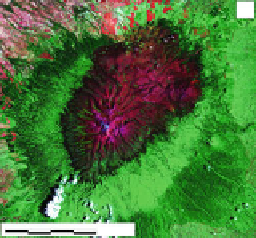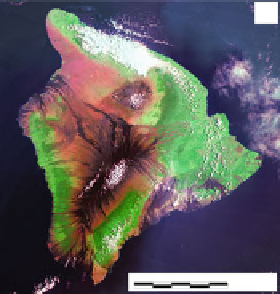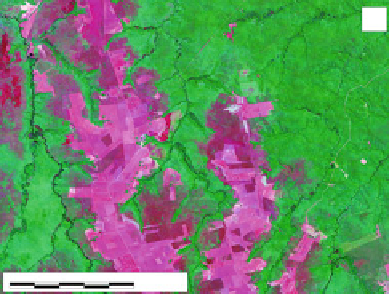Environmental Engineering Reference
In-Depth Information
a
b
0
5
10
15
20 Kilometers
c
0
10
20
30
40
50
Kilometers
d
0
5
10
15
20
25
Kilometers
Fig. 9.1 Satellite images showing a variety of natural and human-generated ecotones at several
spatial scales: (a) Ecotones in the Sahel region of Africa (see text). (b)Altitudinal ecotones between
vegetation belts in Mt. Kenya. (c) Natural and human-made ecotones on Hawaii's big island.
Ecotones vary over different slopes and elevations. Note also the sharper ecotones in areas where
lava has flowed. (d) Human-related ecotones resulting from deforestation (in
pink
) in the Amazon
Basin, Brazil. On the far
left
and far
right
, in dark green, natural riparian ecotones can be detected
along the rivers. (Source of Fig. a St¨ckli et al. [
39
] NASA Blue Marble Next Generation, August
2004. True color composite of MODIS satellite images. Downloaded from:
http://visibleearth.nasa.
gov/
[
42
].) (Source of Fig. b-d MDA Federal [
25
] NASA GeoCover circa 1990 Landsat images.
False color composite of Landsat bands 7, 4 and 2.
Green shades
represent vegetation,
magenta
and
brown
represent bare soil,
black
represent water bodies, recent lava flows of shadows,
cyan shades
[
3
].) (All images are public domain. The figures were produced by Noam Levin)
ecological framework for the study of ecotones was given by Odum in 1953. Odum
discussed the ecotone effect, which he characterized as increased richness and
abundance in ecotones and the occurrence of unique ecotonal species. Until the
1970s, there was considerable interest in ecotones within the scientific community
(reviewed by [
32
]). This interest subsided as focus on more homogenous and
well-defined ecosystems and communities (e.g., tropical rain forests and tundra)
became common. A revival of research in the field focusing on ecotones and their
effects on biodiversity was seen in the late 1980s and 1990s, with the development
of new research areas, especially those of landscape ecology and of conservation







